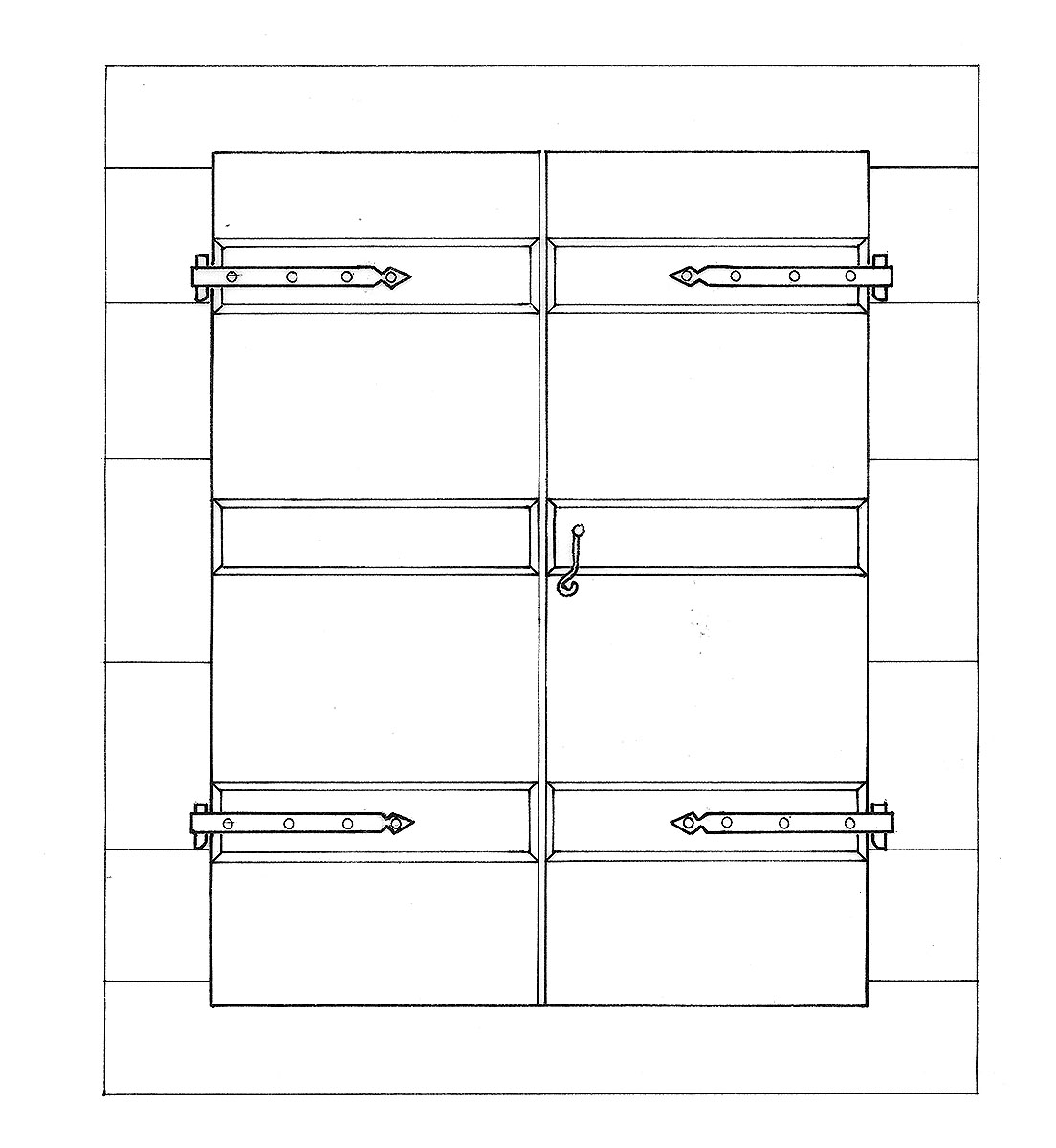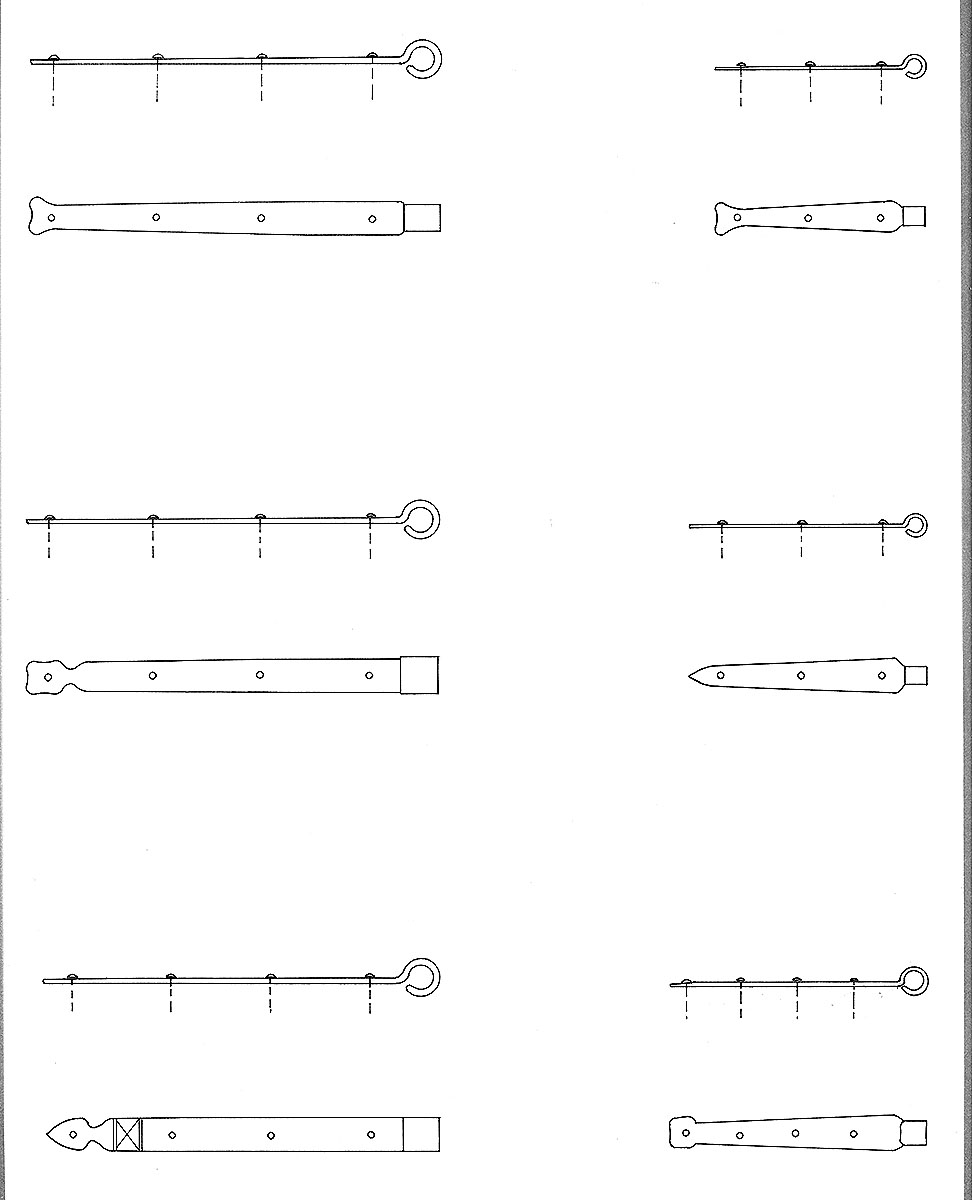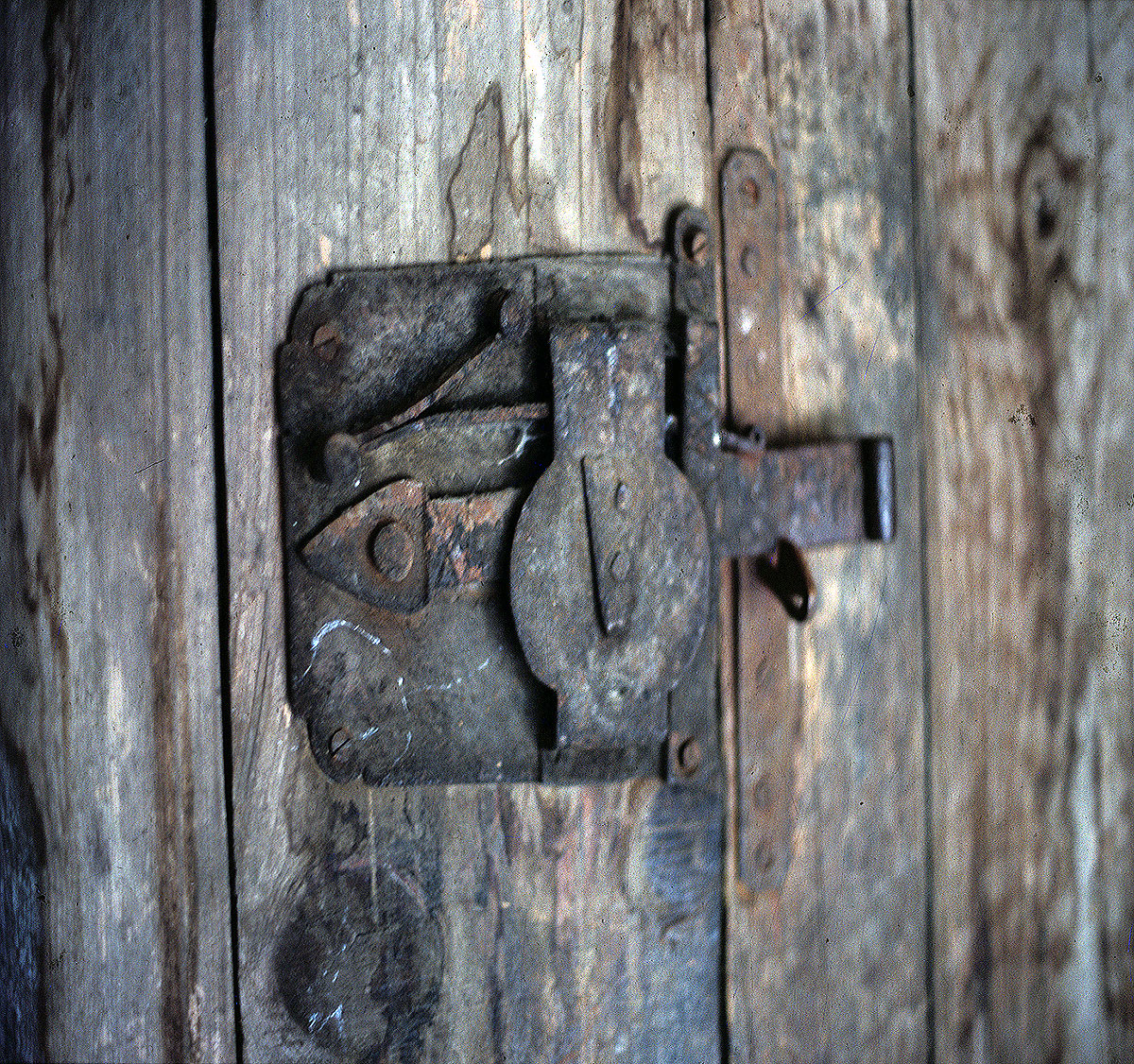Ironwork
Metallic structural elements
Metal Window Fittings
Support: The windows, like the doors, are hung on strap hinges placed before the window-frame has been completed, the pintles in the frame itself and the flanges on the inner side of the window.
In order to hold open one of the two window-leaves, the kondomiri strut is placed on the inside of the leaf.
Handles: The window has rings fitted to the inside of one leaf by which to open and close it. The rings are usually plain or have a decorative rosette, making them resemble small kerkelia.

Panelled upper room shutters, inside and outside view. The outside is flush with the façade. The inside is barred. Inside view. 7 Melissinou Street, Rethymnon.
Security: The windows are secured by iron bars (sideria), to which the shutters are attached by means of a “hook” placed on either the inside or the outside of the shutter, depending on whether the window is on the ground or the upper floor. On ground-floor windows the bar is on the outside of the aperture, so the hook is on the outside of the shutter. For windows on the upper floor, the bar and hook are both usually on the inside.
The shutters open either inwards or outwards. When they open outwards, each shutter is attached to the wall with a special metal fixture so it won’t bang in the wind. The fixture is set under the aperture in the outer wall and projects to a distance equal to the width of the shutter, so that when the shutter is open the fixture is flush with its surface.

Panelled upper room shutters, inside and outside view. The outside is flush with the façade. The inside is barred. Outside view. 7 Melissinou Street, Rethymnon.
Maskoula (Strap Hinges)
Strap hinges are chiefly used to support the wooden frames in their casings. They are made of metal and divided into two interdependent and supplementary parts: pintles (male maskoula) and flanges (female maskoula).
Pintles
Pintles are mounted on the casing of the door or window during construction. They are divided into two types of different shape, depending on whether the casing is made of stone or wood.
When the casing is made of stone, the pintle consists of a cylindrical section 2-8 cm high and 1-2 cm in diameter (depending on the weight of the frame to be hung on it), at right angles to its flat flange, whose end is twisted into an opposite right angle which hooks between the masonry where it is mounted. The whole pintle is about 15 cm long.

Panelled yard door, inner face. Vori, Western Mesara.
When the casing is made of wood, the cylindrical part of the pintle is at right angles to its flange, which is in the shape of a giant nail. This allows it to be nailed to the wooden casing.
When the casing is made of single blocks of stone, the pintle is nailed into position and the gap is filled with plaster glue made of old bones ground with lime or melted sulphur. Heated wedges were also often used. The whole construction is very stable and can support even the heaviest wooden frame.
The pintles were made by smiths (halkiades). They used rods of the appropriate length and diameter, which they heated and bent at a length of 3 cm, hammering the remaining section into a flat flange or pointed nail. Each piece was finished according to its final use. The flange of the strap hinge is set into the cylindrical section of the pintle.

Panelled yard door, outer face and horizontal section. Vori, Western Mesara.
Flanges
Flanges are mounted on the door itself, and specifically on the traverses. They are elongated metal objects with one end bent in order to be inserted into the pintles already mounted on the casing. This forms a joint which supports the door and allows it to open and close freely. Two flanges are mounted on singe doors and four on double doors, two to each leaf.
The size of the flanges varies depending on the weight of the door they are meant to support. Flanges 25-35 cm in length are usually fitted to inner doors and small outer doors, while those on main and courtyard doors are 35-55 cm long. Smaller flanges 17-25 cm long are used on window shutters.
Most flanges are fixed with three nails and the larger ones with four. The nails are also fire-forged in the halkiadika (copper-smithies). They are single, 5-6 cm long and the diameter of the head is about 80 mm. After attaching the flange to the traversa, the nails pass through the board and are nailed back on the inside to secure them further.
Flanges are visible elements on the inner side of the door, and so are elaborately made. However, the variety of shapes is limited. The end of the flange is beaten into a heart or other shape when red-hot.
Apart from the common flange, in rare cases we see another type of hinge which is secured to the door by two horizontal flanges. Some flanges used on window shutters may extend the whole width of the shutter.

Mendesedes Or Bastouvania (Hinges)
Another type of hinge is the bastouvani. This is comprised of two articulated metal parts similar to flanges. It is used on the upper door (panoporti) of the outer door (one part mounted on the door and the other on the panoporti) and on single inner doors.
Kondomiri (door strut)
This is an iron rod of proportional length and diameter to the size of the door. It is placed diagonally, holding one leaf of a double door open against the wall. Some large doors had two struts on the fixed leaf and one on the moveable leaf for greater security.

Panelled front door, inner face. Vori, Western Mesara.
Zeberedes (Thumb Latches)
The zeberes is a metal object designed to allow the door to be opened and closed from the outside, fastening it without actually locking it.
The door is secured by an oblong, horizontal metal rod called a beratis. (Doors secured by the perato and antiperato – a sort of wooden bolt – whence the word beratis).

The beratis rises and falls, either directly by turning the handle or by pressing the betouyia (thumb latch) depending on the type of latch, and falls into or rises out of the socket in the other door leaf.
An open U-shaped metal handle is nailed into the door at right angles to the beratis. It has a slightly flattened upper surface and triangular, pointed prongs for nailing it to the wood more easily. This handle is called an asfalia (“safety”), as it holds the beratis in position and prevents it from falling off.

Types of thumb latch: There are two basic types of thumb latch, depending on their shape and operation. We will call the first the “key” zeberes, due to the shape of the grip. This is comprised of the following elements: the key-grip and the decorative rosette escutcheon, which are placed on the outside of the door; and the beratis, the asfalia and the kokoras (“trigger”) of the zeberes, set on the inside of the door.
The second type is completely different in shape but operates according to the same principle. The grip is almost semi-circular and ends in a decorative flourish, usually in the shape of an eagle’s head or a cross. The zeberes is comprised of the semi-circular grip with the incorporated betouyia, placed on the outside of the door; and the beratis, the asfalia and the kokoras of the zeberes, set on the inside of the door.
These relatively small metal objects are carefully wrought with attention to decoration that always extends to the smallest detail.

Locks
There has always been a need for additional personal and family security in the home, whether the inhabitants are there or not. This led to the development of security devices for the outer door from a very early stage.
Apart from the wooden crossbar used to secure the door from the inside, security systems developed that were operated by a key which moved a bolt (usually wooden) horizontally. Once iron became freely available and skills needed to work it developed and spread, these systems evolved into the lock. The development and improvement of locks and keys by local smiths continues to this day.
The operating principle remains the same. The aim is to move an oblong horizontal bolt with the end of the key. The way in which the bolt can be made to remain securely in place once the key has been removed from the lock, has always been a vital part of the locksmith’s art.
Zeberes Lock
The name of this latchbolt lock is derived from the fact that it operates in the same way as the thumb latch. The lock is comprised of various elements mounted on a square metal plate with a keyhole. This plate is nailed to the inner side of one leaf of a double door, just above the middle of the door, near the edge closest to the opposite leaf.
Construction : on one side of the lock plate, more or less in the middle, is placed a horizontal rod (the bolt or beratis ), fixed at one end so as to move vertically. Above and parallel to the beratis is nailed a forked spring ( lavida ), one prong of which touches the beratis and may be pushed up by vertical pressure. The asfalia (safety) is placed at right angles to the beratis and the lavida.

The asfalia is an open U-shaped metal object with a flattened upper surface and triangular, pointed prongs, with their tips at right angles so they can be nailed to the metal plate. The asfalia holds the bolt in a horizontal position and prevents it from falling. The whole is partially covered by the lid of the lock, forming the keyhole.
The key is turned in the keyhole, and the bit (the end of the key) pushes the bolt up. The bolt compresses the spring and rises, allowing it to enter or be withdrawn from the socket in the opposite leaf of the door, thereby locking or unlocking it. When the key is withdrawn from the lock, the spring is released and returns to its original position, fixing the bolt in place for increased security.
These locks have a keyhole only on the outside of the door. However, the door also needs to be unlocked from the inside. For this purpose, a small vertical fitting (the thumbturn) is attached to the free end of the bolt, so it can easily be lifted by hand and allow the door to be opened or closed from the inside.

It must be noted that all the lock components are metal. This type of lock is more elaborately made than any of the other types of lock discussed below, with wrought iron decoration.
In a development of the zeberes lock , the forked spring was replaced by a coiled spring whose straight section compressed the bolt. The system remained the same, being locked and unlocked using a key from the outside and by hand from the inside.
Later there was a significant change in the axis of movement of the beratis, from vertical to horizontal.
The bolt is now supported by two asfalies , one at each end of the bolt, allowing free horizontal movement.
The spring becomes more complex, an open ovoid in shape, with one fixed and one free end. The upper end of the spring is notched to engage the corresponding depressions in the upper edge of the beratis. The spring is placed immediately above the beratis, so that before the key touches the latter it pushes the spring up, freeing the beratis and allowing it to move either forwards, locking the door, or backwards unlocking it. The lock cannot now be operated from the inside. The lid of the lock is still elaborately and imaginatively decorated.
As the lock developed, according to the same principles, an inner bolt was added so the door could be secured from the inside. The lid of the lock was simplified until it became square, while the keyhole ceased to be ornamented and became a simple rectangular box.
Escutcheon
Often the outer side of the keyhole is framed by a decorative metal plate – the escutcheon – in various shapes, most often an eagle’s head.

Nailed front door of a Venetian villa. 236 Arkadiou Street, Rethymnon.
Keys
Keyholes may be operated by pin stem or pipe stem keys depending on their construction.
Pipe stem keys are comprised of a cylinder in a variety of lengths, a heart or oval bow (top part), and a bit (end) at right angles to the cylinder, the louvi.
The cylindrical stem is hollow and slides onto a fixed pin in the lock, so the key moves around a set axis without jiggling around and possibly being damaged. The bit is carved with grooves, usually parallel to the stem of the key, and notches to ensure that each key fits a single lock and can be told apart from others.
We have found an infinite variety of key sections, shapes and designs, but the general pattern is always the same.
Pin stem keys are rare and were probably developed later. The bit is placed just above the end of the solid cylindrical stem, with small variations. It is designed to fit into a corresponding socket in the back plate of the lock.
